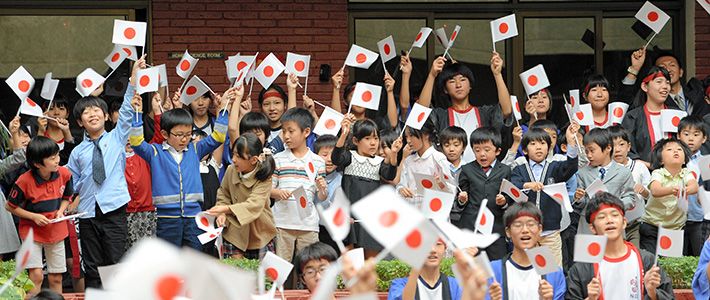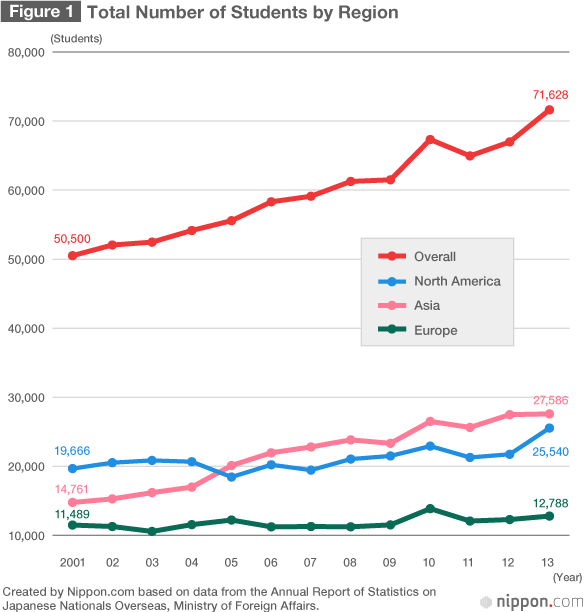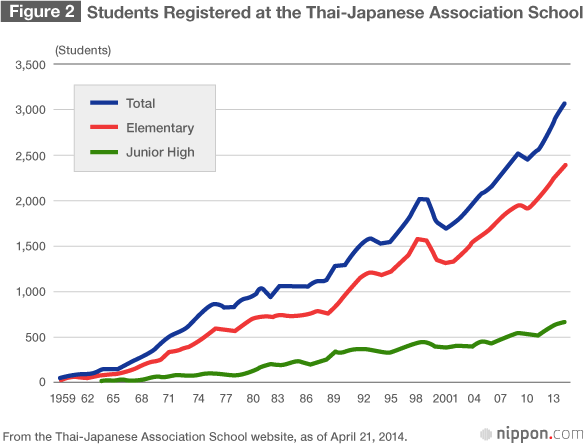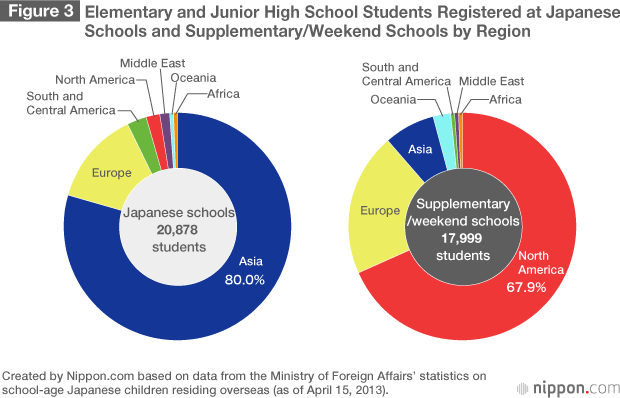
Japanese Children at School Around the World
Society- English
- 日本語
- 简体字
- 繁體字
- Français
- Español
- العربية
- Русский
There were 1,258,263 Japanese people living abroad as of October 1, 2013, a rise of 8,686, or 0.7% compared with the previous year. This figure from the Ministry of Foreign Affairs, which does not include tourists and others who are staying for less than three months, is the highest since records began in 1968. Compared with five years before, the increase is even more pronounced at 126,456, or around 11%. And with the greater number of Japanese living in other countries, the number of elementary and junior high school children studying at Japanese schools overseas is also increasing, whether they are at one of the 88 Japanese schools officially recognized by Japan’s education ministry, the 8 private schools that follow the Japanese curriculum, or the 203 supplementary or weekend schools.
As of May 1, 2013, there were 71,628 Japanese children enrolled at schools overseas (whether Japanese, local, or international), up from 66,975 the previous year and 52,462 in 2003—an increase of nearly 20,000 over the course of the decade. In Europe and South and Central America, numbers increased slightly, while in the Middle East and Africa they remained largely unchanged. In Oceania they decreased slightly, but in Asia they rose significantly. In North America too, figures showed an overall rise, despite fluctuations, with a sudden spike from 2012 to 2013. One Japanese company manager noted, “The upsurge may be connected with moves among Japanese companies to reassess the North American market.”

In Asia, there were 27,586 Japanese children enrolled in schools overseas as of May 1, 2013, a major increase of around 70% compared with 16,184 in 2003. In 2003, 20,848 students were attending schools in North America—more than in Asia—but by 2005, Asia had moved ahead, surging to 20,113 while the North American figure fell to 18,445. Given that Japan-China trade outstripped Japan-US trade in 2004, this is understandable. However, the North American numbers later rose again, and with the jump from 21,738 students in 2012, to 25,540 in 2013, the region came close to matching the Asian total. Figures for the other regions are 12,788 students in Europe, 2,293 in Oceania, 1,784 in South and Central America, 1,013 in the Middle East, and 624 in Africa. From this data it is possible to discern how closely connected Japan is to the various regions.
Bangkok Home to World’s Largest Japanese School
At Japanese schools in Bangkok and Shanghai, student numbers have leaped over the past decade. As of April 2014, there were 3,052 elementary and junior high school children attending the Thai-Japanese Association School in Bangkok, making it the world’s largest Japanese school overseas. The Shanghai Japanese School comes in second place with a total of 2,790 students, comprising 1,412 at the Hongqiao elementary campus and 1,378 at the Pudong junior high campus. However, according to a school staff member, student numbers dropped by 260 over the past year, which would mean Shanghai was top in the world until last year.
One factor in this drop would seem to be pollution in China, including the particularly dangerous fine-particle PM2.5 pollution that has made major headlines in Japan. Anti-Japanese demonstrations and withdrawal from China by Japanese companies engaged in labor-intensive activities have also contributed to the decrease. “When employees with families return to Japan, often those who are newly posted [to Shanghai] leave their children in Japan,” a manager at one Japanese company comments.

Parents More Likely to Choose Local Schools in English-Speaking Countries
There are major differences in the proportion of Japanese children who attend official Japanese schools in different regions. In largely English-speaking regions, it is much less common for children to go to these schools: Only 413 out of the 25,540 Japanese children (1.6%) living in North America and 140 out of 2,293 (6.1%) living in Oceania do so. By comparison, 16,710 out of 27,586 (60.5%) living in Asia, 573 out of 1,784 (32.1%) living in South and Central America, and 323 out of 1,013 (31.9%) living in the Middle East attend official Japanese schools. The figures for Europe and Africa are 20.5% and 14.8%, respectively.
In North America and Oceania, many children attend either local or international schools, taking Japanese lessons on the weekend or after school at supplementary institutions. Parents apparently see the thorough knowledge of English their children will gain through study at local or international schools as a plus for them when they return to Japan. However, as knowledge of languages other than English does not help students pass college admission exams in Japan, it is common in non-English-speaking countries to choose a Japanese school where the classes are in step with the curriculum back home.

Thousands of Returnee Children
Every year, thousands of Japanese children return to Japan from overseas. The education ministry formally defines returnee children as those of parents working overseas who have spent more than one year in another country. In its Basic Survey of Schools, the ministry found that there were 10,591 returnee children in the period between April 1, 2012, and March 31, 2013, an increase of 6.1% on the previous year.
Of these, 6,182 were elementary school students, 2,343 were junior high school students, 1,951 were high school students, and 115 were students at secondary schools (combining the junior high and high school stages). The reason for the high proportion of elementary school students (around 60%) is that junior high school and high school students increasingly remain in Japan even when their parents move abroad due to concerns over preparation for high school or university entrance examinations. The Japanese education system remains unforgiving to students with nonstandard schooling, despite their growing numbers.
(Originally written in Japanese and published on December 3, 2014. Banner photo: Japanese School New Delhi, India. © Jiji.)